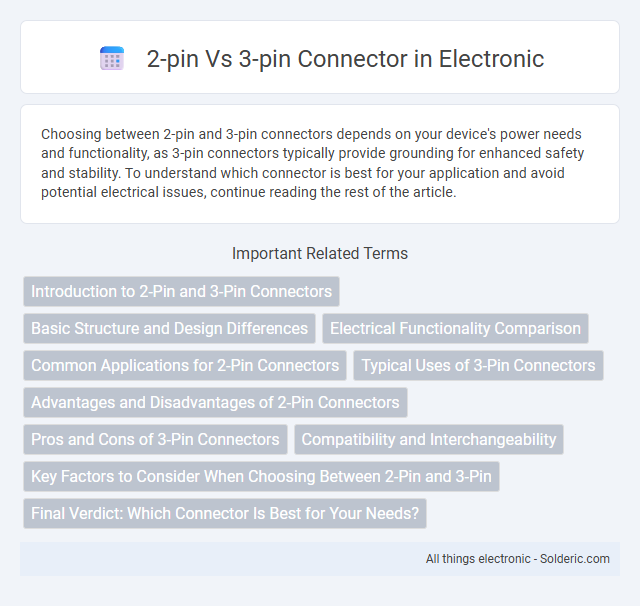Choosing between 2-pin and 3-pin connectors depends on your device's power needs and functionality, as 3-pin connectors typically provide grounding for enhanced safety and stability. To understand which connector is best for your application and avoid potential electrical issues, continue reading the rest of the article.
Comparison Table
| Feature | 2-Pin Connector | 3-Pin Connector |
|---|---|---|
| Number of Pins | 2 (Power & Ground) | 3 (Power, Ground & Signal) |
| Functionality | Basic power supply | Power with data signal support |
| Common Use | Simple devices, basic LED strips | Devices needing feedback, RGB LED strips, fans |
| Signal Transmission | No signal, power only | Supports PWM or data signals |
| Compatibility | Limited to non-smart devices | Compatible with smart or addressable devices |
| Cost | Lower | Higher due to added signal pin |
Introduction to 2-Pin and 3-Pin Connectors
2-pin and 3-pin connectors are commonly used in electronic devices to connect power or signal lines. A 2-pin connector typically carries power through two wires: positive and negative, ideal for simple devices requiring basic power supply. The 3-pin connector adds a third wire, often used for grounding or signal transmission, providing enhanced stability and functionality for more complex applications.
Basic Structure and Design Differences
A 2-pin connector consists of two conductive pins used primarily for simple power connections, while a 3-pin connector adds an additional pin often designed for grounding or signal transmission, enhancing safety and functionality. The basic structure of a 3-pin connector includes a third pin that stabilizes the connection and prevents electrical hazards, making it ideal for devices requiring grounding or data feedback. Your choice between these connectors depends on the device's power needs and the level of connection security required.
Electrical Functionality Comparison
A 2-pin connector provides a basic electrical connection with one pin for live current and the other for neutral, suitable for simple power needs. A 3-pin connector adds a ground pin, enhancing safety by preventing electric shock and equipment damage through proper grounding. Understanding these differences helps ensure Your electrical devices are connected with the appropriate level of protection and functionality.
Common Applications for 2-Pin Connectors
2-pin connectors are commonly used in low-power applications such as LED strip lighting, small electronic devices, and power adapters where simple power transfer is required. These connectors provide a reliable connection for positive and negative terminals, ensuring efficient current flow with minimal risk of incorrect polarity. Their compact design and ease of use make them ideal for consumer electronics and automotive accessory installations.
Typical Uses of 3-Pin Connectors
3-pin connectors are commonly used in computer cooling fans, where the additional pin provides a tachometer signal for precise fan speed monitoring. They are also prevalent in audio and data communication equipment, offering enhanced grounding and control capabilities. Industrial automation systems utilize 3-pin connectors for reliable power and signal transmission, ensuring improved safety and performance.
Advantages and Disadvantages of 2-Pin Connectors
2-pin connectors offer simplicity and ease of use, making them ideal for basic power or signal connections where grounding is not critical. Their compact design reduces cost and space requirements but lacks the safety and stability provided by the third pin for grounding or extra signal lines. You should weigh the reduced protection against potential interference or electrical hazards when choosing 2-pin connectors.
Pros and Cons of 3-Pin Connectors
3-pin connectors offer the advantage of an additional pin for grounding, enhancing safety and reducing electrical noise compared to 2-pin connectors. They provide more secure and stable connections, making them ideal for applications requiring reliable power and signal integrity. However, 3-pin connectors tend to be bulkier and slightly more expensive, potentially complicating installations where space or cost is a concern.
Compatibility and Interchangeability
2-pin and 3-pin connectors differ primarily in compatibility and interchangeability, where 3-pin connectors support an additional ground or signal wire, making them suitable for applications requiring more reliable grounding or data transfer. While 2-pin connectors are commonly used for simple power connections, they are not interchangeable with 3-pin connectors due to their physical design and lack of a third terminal. Ensuring connector compatibility is crucial to prevent electrical faults and maintain device functionality, as mismatched connectors can lead to improper connections or damage.
Key Factors to Consider When Choosing Between 2-Pin and 3-Pin
Key factors to consider when choosing between 2-pin and 3-pin connectors include the type of signal and power requirements of your device. A 2-pin connector is suitable for simple power supply needs, while a 3-pin connector supports additional functionality like data transmission or grounding for improved safety. Evaluate your device's compatibility and the necessity for stable grounding or signal control to ensure optimal performance.
Final Verdict: Which Connector Is Best for Your Needs?
A 3-pin connector offers enhanced stability and grounding, making it ideal for applications requiring reliable power delivery and reduced electrical noise. A 2-pin connector is simpler and sufficient for basic devices without grounding needs, providing cost-effective and compact solutions. Your choice depends on device requirements for safety and performance, with 3-pin connectors generally preferred in environments demanding enhanced electrical protection.
2-pin vs 3-pin connector Infographic

 solderic.com
solderic.com